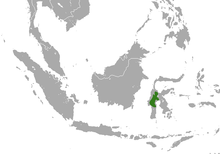- Pygmy tarsier
-
Pygmy tarsier[1] 
Conservation status Scientific classification Kingdom: Animalia Phylum: Chordata Class: Mammalia Order: Primates Family: Tarsiidae Genus: Tarsius Species: T. pumilus Binomial name Tarsius pumilus
Miller & Hollister, 1921
Pygmy Tarsier range The pygmy tarsier (Tarsius pumilus), also known as the mountain tarsier or the lesser spectral tarsier, is a nocturnal primate found in central Sulawesi, Indonesia, in an area with lower vegetative species diversity than the lowland tropical forests. The pygmy tarsier was believed to have become extinct in the early 20th century. Then, in 2000, Indonesian scientists accidentally killed one while trapping rats. The first pygmy tarsiers seen alive since the 1920s were found by a research team, graduate student Nanda Grow and undergraduate student, Jennifer Moehlman, from Texas A&M University on Mount Rore Katimbo in Lore Lindu National Park in August 2008.[3][4] The two males and single female (a fourth escaped) were captured using nets, and were radio collared to track their movements. As the first live pygmy tarsiers seen in 80-plus years, these captures dispelled the belief among some primatologists that the species was extinct.[5]
Shortly after the news came out that the pygmy tarsier was re-discovered in 2008 the species developed a cult following in the US[citation needed]. The group has regular meetings, t-shirts, members from all over the world and a facebook group called "Pygmy Tarsier Fan Club", which was founded by Chip Worthington and Matt Munoz.
Contents
Physical description
The pygmy tarsier has a head-body length of 95 to 105 mm (about 4 inches), and weighs less than 57 grams (2 ounces). T. pumilus has very distinct morphological features, a body length which is smaller than other tarsier species, and a small body weight. It also has smaller ears than the rest of the genus, and its fur is tan or buff with predominant grey or brownish red coloring. The tail is heavily haired and ranges from 135 to 275 mm. The most noticeable feature of T. pumilus are its large eyes, about 16 mm in diameter. The pygmy tarsier also has nails on all five digits of each hand and on two digits of each foot. The claw-like nails aid in its grasping strength and are also used as an aid in its need for vertical support for feeding and movement.
Behavior
T. pumilus is found in stable bonded pairs, remaining together for up to 15 months. This stable pair bond is usually monogamous. The species has two breeding seasons, one at the beginning of the rainy season and the other at the end, separated by about 6 months. Gestation lasts 178 days on average, and births occur in May and from November to December. Infants are quite precocial, and develop quickly, similar to other juveniles in the genus. The offspring begin capturing their own prey around 42 days of age, and travel in groups after only 23 days. Young females remain with parents until adulthood, while young males leave the natal group as juveniles.
The pygmy tarsier is nocturnal or crepuscular, and is mainly arboreal. It spends most of the daylight hours sleeping on vertical branches in the canopy. T. pumilus is not a nest builder. Unlike other tarsier species, it does not use scent glands to mark territorial boundaries.[5] Also, tactile communication and interaction is important with the Pygmy Tarsier, as in other tarsier species.
Diet
Tarsiers, in general, are insectivorous, and tarsiers are the only primates that are completely carnivorous. They eat arthropods, and there are anecdotal stories[citation needed] of T. pumilus capturing birds and snakes. As insectivores, they also play an integral role in their habitat in structuring the insect community and in the local food webs.
References
- ^ Groves, C. (2005). Wilson, D. E., & Reeder, D. M, eds. ed. Mammal Species of the World (3rd ed.). Baltimore: Johns Hopkins University Press. pp. 128. OCLC 62265494. ISBN 0-801-88221-4. http://www.bucknell.edu/msw3.
- ^ Shekelle M & Salim A (2008). Tarsius pumilus. In: IUCN 2008. IUCN Red List of Threatened Species. Downloaded on 18 November 2008.
- ^ Dunham, Will (2008-11-18). "Tiny, long-lost primate rediscovered in Indonesia". Reuters U.K.. http://uk.reuters.com/article/scienceNews/idUKTRE4AH96X20081118. Retrieved 2008-11-19.
- ^ [|Locke, Susannah F.] (2008-11-19). "Tiny primate rediscovered in Indonesia". Scientific American. http://www.sciam.com/blog/60-second-science/post.cfm?id=tiny-primate-rediscovered-in-indone-2008-11-19. Retrieved 2008-11-19.
- ^ a b Boyle, Alan (2008-11-18). "Real-life Furbys rediscovered". MSNBC. http://www.msnbc.msn.com/id/27786771/. Retrieved 2008-11-19.
External links
Extant species of family Tarsiidae Tarsius
(Tarsiers)T. syrichta group: Philippine Tarsier (T. syrichta) · Horsfield's Tarsier (T. bancanus)
T. tarsier group: Spectral Tarsier (T. tarsier) · Dian's Tarsier (T. dentatus) · Lariang Tarsier (T. lariang) · Peleng Tarsier (T. pelengensis) · Sangihe Tarsier (T. sangirensis) · Pygmy Tarsier (T. pumilus) · Siau Island Tarsier (T. tumpara)CategoryCategories:- IUCN Red List data deficient species
- Animals described in 1921
- Mammals of Indonesia
- Tarsiers
Wikimedia Foundation. 2010.

